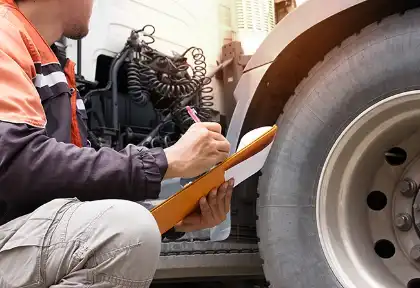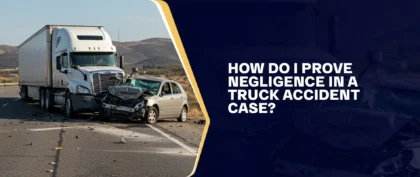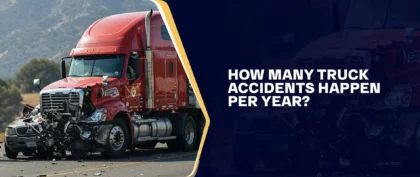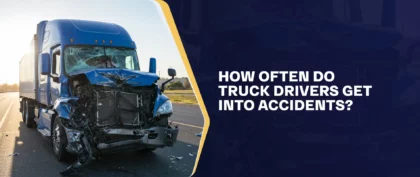Table of Contents
Trucks help keep the lifeblood of our economy flowing. The role these massive vehicles play in the supply chain is fundamental. Trucks are instrumental in “making things move” within the economy by transporting essential goods from manufacturers to distributors and then to customers. However, their increasing presence on our roads also raises the risk of tragic accidents that can result in life-altering injuries and fatalities.
While various factors contribute to truck accidents, driver error represents one of the primary causes of truck accidents. Distracted driving, speeding, and other types of driver errors all play a major role in these crashes. Interestingly, all these factors show us that truck accidents and their potentially catastrophic consequences can be prevented. This is why addressing them promptly is crucial, as these tragic events remain a pressing concern, especially in major areas like Los Angeles and Pasadena’s 210 Freeway.
What Is The Cause Of A Truck Accident?
Driver error is a major factor in truck accidents across California and the United States. These mistakes often occur when motorists fail to practice safe driving or disregard traffic signs and road rules.
Such negligent driving can take many forms, including the following:
- Misjudging distances
- Using phones and other distractions while driving
- Driving recklessly
- Tailgating or following another vehicle too closely
- Overcorrecting
- Driving too fast
- Failing to take mandated breaks
- Taking dangerous lane changes
- Driving right after taking medication that adversely affects the body
- Driving while drunk or high on drugs
- Failing to check the vehicle adequately before driving
Unfortunately, negligent drivers who commit these errors put themselves and other road users at risk of injury or death.
Truck Drivers Are On The Roads Eight Times Longer Than Other Drivers
Most long-haul truck drivers log 80,000 to 110,000 miles annually, while the average American driver only covers around 12,000 to 14,000 miles.
This significant difference in road time may translate to a higher risk of being involved in an accident. Long hours behind the wheel can lead to impaired judgment and decision-making. Repetitive routes and long stretches of highway can cause a decline in alertness and an increased risk of mistakes.
Driver Errors Resulting In A Truck Accident
Strict schedules and tight delivery windows imposed by trucking companies or logistics service providers (LSPs) can also incentivize dangerous driving behaviors, such as:
Driving Under The Influence (DUI)
Alcohol, drugs, and certain medications can adversely affect reaction time, coordination, judgment, and decision-making. Some illegal substances may even alter perception and distort reality, causing a driver to react recklessly and unpredictably. In an accident, these impaired drivers can’t think straight and may leave the scene, resulting in a hit-and-run.
While the State of California has already released a comprehensive safety plan for reducing impaired driving, the number of DUI accidents is still rising. Driving while intoxicated is both a criminal offense and a breach of a driver’s duty of care. If the driver causes an accident, they could face civil court lawsuits, criminal charges, and fines.
California has a BAC limit of 0.04% for drivers operating a vehicle that requires a commercial driver’s license (CDL). This is higher than the normal legal limit of 0.08% for non-commercial drivers. This stricter limit reflects the increased risk a massive vehicle poses in the hands of an impaired driver.
Distracted Driving
A distraction is any activity that diverts a truck driver’s attention from safely operating the vehicle. Some examples include eating, drinking, using mobile phones, and conversing with other occupants. Truckers distracted while driving may cause an accident by failing to react to traffic events or notice a red light.
Let’s take the use of phones while driving as an example. According to the National Highway Traffic Safety Administration (NHTSA), sending a single text can take a driver’s eyes off the road for five seconds. In that brief window, their vehicle would have traveled the entire length of a football field at 55 mph. Any road hazard the driver might fail to see could result in an accident.
Speeding
Another common cause of truck crashes is speeding. According to California Vehicle Code 22350, drivers must drive safely and responsibly, regardless of the posted speed limits.
Adverse weather and road conditions, in particular, demand extra caution from truck drivers. They must drive slower than the speed limit since it can be hard to slow down and stop when there’s rain, fog, snow, and ice.
A speeding dump truck, for instance, causes extensive damage in a crash, especially to smaller, lighter cars. High speeds, combined with the truck’s large size and weight, build up enough force to cause catastrophic injuries and fatalities during collisions.
Reckless Driving
Both commercial and non-commercial drivers frequently exhibit reckless driving behaviors. They might violate traffic laws, run red lights, weave through traffic, fail to yield the right-of-way, and change lanes without using turn signals. These actions create dangerous situations that put other road users at risk.
Tailgating, for example, is especially dangerous when a large vehicle, such as an Amazon truck, is involved. These trucks have a longer stopping distance than passenger vehicles — 196 feet compared to the average of 133 feet (when traveling at 55 mph in ideal conditions). When a truck driver follows too closely, they might not be able to brake in time, causing them to rear-end the vehicle in front.
Drivers must maintain a safe following distance at all times. A general rule of thumb is maintaining at least one second of distance for every 10 feet of vehicle length below 40 mph. For example, a 70-foot tractor-trailer should maintain a seven-second distance behind the front car.
Fatigued Driving
Truck drivers typically take long-haul routes. However, these extended periods behind the wheel make them more susceptible to fatigue. Similar to DUI, fatigue impairs reaction time and decision-making. Recognizing this critical risk, federal and local governments have established regulations limiting the number of hours a truck driver can be on the road.
The Federal Motor Carrier Safety Administration (FMCSA) limits truck drivers to a total of 11 hours of driving within a 14-hour period. The Hours of Service (HOS) regulations also impose a 30-minute off-duty break for drivers after 8 hours. Drivers must be off duty for ten consecutive hours to reset their workday.
Additionally, drivers cannot drive more than 60/70 hours within 7/8 consecutive days. They must take 34 or more consecutive hours off duty to restart their workweek. Many accidents can be easily prevented if only drivers of delivery trucks and other commercial vehicles adhere to these regulations and take proper rest.
Why Do Truck Drivers Violate Hours Of Service Regulations?
Despite the hours-of-service regulations, some truckers still drive while exhausted. They could lack sleep for personal reasons or deliberately violate truck and traffic regulations to reach their destinations more quickly.
Tight deadlines set by trucking companies can create a strong incentive for drivers to break HOS rules. Truckers may drive for longer stretches to avoid penalties, pay cuts, or even losing their jobs. Moreover, these companies sometimes assign routes and schedules that are impossible to complete within legal driving hours. They might also pressure drivers who haven’t finished the mandatory off-duty rest periods to continue driving.
Exhaustion takes a heavy toll on truckers. A fatigued driver struggles to concentrate, makes poor decisions, and reacts more slowly. They also face the terrifying possibility of succumbing to exhaustion and falling asleep at the wheel.
Lack Of Proper Training As A Cause Of Driver Error
Trucking companies have a duty to provide adequate training to their drivers before they begin operating commercial vehicles. This responsibility goes beyond simply meeting the minimum legal requirements for training. Truck companies should also invest in continuous education and skill development. Training classes should cover topics such as:
- Vehicle operation
- Safety protocols
- Emergency response techniques
- Compliance with regulations
How Do Shortages Impact The Training And Safety Of New Truck Drivers?
The trucking industry is currently facing a significant shortage of truck drivers. In 2023, the American Trucking Association reported a deficit of 78,000 truckers. Additionally, the industry will need to hire 1.2 million truck drivers over the next decade to meet the increasing freight demands. These factors place immense pressure on the existing workforce.
Companies might be forced to dispatch new drivers before they’re fully prepared to maneuver 80,000-pound vehicles safely. They might expedite the training process, leaving drivers unable to handle emergencies, account for wider blind spots, and judge distances accurately.
As a result, amateur drivers might make mistakes when changing lanes and maneuvering in tight spaces. They might also experience difficulties adjusting their speed appropriately to highway conditions, turns, and changes in the weather.
Truck Drivers Are Required To Perform Inspections
The FMCSA requires truck drivers to conduct regular inspections. Drivers must complete two types of inspections during their trips:
- Pre-Trip Inspection — Before they go on the road, drivers must verify that all parts of the truck are functioning correctly, including:
- Brakes
- Engine
- Tires
- Steering mechanism
- Lights and reflectors
- Horn
- Windshield
- Mirrors
- Coupling devices
- Emergency kit
This inspection must also include reviewing the previous post-trip report. Before starting the trip, drivers must confirm that all previously identified issues have been addressed.
- Post-Trip Inspection — After the trip, drivers should do another inspection to identify any issues that might have occurred during the journey.
Drivers must complete a Driver Vehicle Inspection Report to document any issues they discover during their inspections.
How Does Negligent Truck Inspection Contribute To A Truck Accident?
People asking, “What is the primary cause of truck accidents?” are often surprised to discover that poor vehicle maintenance is also a major contributor to these crashes. When truck inspections are skipped or performed poorly, critical safety problems can go unnoticed. As a result, the driver might encounter mechanical defects during the trip, such as tire blowouts, brake failure, and steering problems. All of these can cause a devastating accident.
Several factors contribute to negligent inspections. Tight schedules and demanding deadlines can pressure drivers to skip inspections or rush through them, overlooking crucial checks. Furthermore, drivers may not have acquired adequate training on conducting proper inspections, leaving them unequipped to identify potential problems.
What Are The Other Causes Of Truck Accidents?
Truck drivers are not the only ones typically at fault. There could be other reasons contributing to an accident, including the following:
Overloaded Trucks
If you have experience driving along freeways and highways, you might have seen signs for truck weigh stations. These areas are where trucks and their cargo are inspected to check if they follow Department of Transportation (DOT) regulations about overloading. According to California Vehicle Code Section 2813, all commercial vehicles are required to stop at these stations when:
- The California Highway Patrol is conducting inspections.
- There are signs requiring drivers to stop.
Commercial trucks are subject to cargo weight limits depending on their base weight and the type of freight being transported. These limits help promote road safety by preventing these vehicles from carrying dangerously excessive loads.
Too much weight might put undue stress on the vehicle’s components, such as the brakes and tires, resulting in premature wear and tear. Moreover, an overloaded truck is harder to maneuver and control, increasing the likelihood of accidents. Despite these risks, trucking companies continue to use this practice to cut costs.
Some delivery trucks may be overloaded to complete more deliveries on a single trip, which can compromise safety and lead to accidents. If this results in an accident, victims may have a valid case. Delivery truck accident lawyers can assist in pursuing a claim and proving liability in this situation.
Road Hazards
Numerous commercial vehicle accidents are caused by dangerous road conditions beyond the driver’s control, from potholes and icy roads to construction zones.
Unfamiliar roads can also present some risks for truck drivers. Urban interchanges, with their intricate network of lanes and exits, can be confusing and may lead to mistakes like driving the wrong way. Meanwhile, rural areas often have narrow roads and steep inclines that are difficult to navigate.
Truck drivers are encouraged to check the current roadway conditions before going on their trip. In California, they can call the Caltrans road condition telephone hotline at (800) 427-ROAD (7623) or visit the Highway Conditions Information web page.
Bad Weather
Although truck drivers usually encounter rain or fog during their trips, they should remain mindful and not underestimate these weather conditions. For example, when the air temperature drops, the rain might turn into ice, which makes the road surface slippery. Truck drivers are encouraged to exit the road at this point to avoid accidents and help reduce risks to their own and other road users’ lives.
Unrealistic Time Constraints
Some trucking companies prioritize their profits above all else, pushing their drivers to transport cargo as quickly as possible. Truckers often have to drive at excessive speeds to meet tight delivery deadlines. This pressure to deliver goods quickly can lead to unsafe driving practices and may compromise the safety of both the drivers and other road users.
How Dangerous Are Truck Accidents?
According to the National Safety Council, more than 5,800 trucks were involved in fatal accidents in 2022. These crashes resulted in catastrophic injuries, damage to property, and even wrongful deaths for other motorists.
Since trucks usually weigh 20 to 30 times more than passenger cars, people in smaller vehicles are more vulnerable to a collision. The heavier the truck is, the deadlier the force it can generate upon impact. Even in a seemingly minor fender bender, the damage a truck can create can be extensive.
In crashes involving motorcycles, bicycles, and pedestrians, trucks tend to cause severe injuries, as these parties have less protection than passenger car occupants. Most truck accident victims commonly sustain any or a combination of the following injuries:
- Whiplash
- Cuts & lacerations
- Head injuries
- Brain injuries
- Back injuries
- Broken bones
- Amputations
- Paralysis
Many of these injuries require extensive medical treatment and costly hospital bills. Victims may also need therapy if they develop psychological problems and other mental health issues due to the accident.
Common Types Of Truck Accidents
Driving along major highways should not be scary. However, accidents are something you cannot ignore. Any of the causes listed above can lead to a wide range of truck accidents, including:
Rear-End Accidents
Most people think that rear-end accidents are minor. However, this is not usually the case when trucks are involved. When an 18-wheeler hits a passenger car in the back, the resulting damage could be devastating, regardless of the truck’s speed. The occupants of the smaller vehicle might sustain whiplash and spinal cord injuries.
Rollover Accidents
Heavy-duty vehicles like trucks and buses have a higher center of gravity than regular cars. This means they’re more likely to fall over when there are sharp turns or strong winds. Overloading these vehicles makes them even more unstable, raising the risk of tipping over. When a truck starts to lose balance, drivers may also instinctively overcorrect, worsening the situation and possibly resulting in a rollover accident.
Jackknife Accidents
A jackknife accident occurs when the trailer swings outward and makes a sharp angle with the cab, resembling a jackknife. Most of the time, these semi-truck crashes happen when drivers stop too quickly or when the roads are wet and slippery. These conditions make it challenging for the driver to maintain control of the big rig and prevent the trailer from swinging dangerously.
T-Bone Accidents
Also known as broadside crashes or side-impact collisions, T-bone accidents occur when a truck crashes head-on with the side of another vehicle. These often occur at intersections where vehicles continuously travel perpendicular to one another and cross paths. Side-impact collisions are more dangerous for passengers seated on the affected side. They have minimal protection against the impact of an 80,000-lb vehicle.
Sideswipe Accidents
Sideswipe accidents happen when a truck crashes into a passenger vehicle side by side. Typically, these collisions involve two motor vehicles traveling in the same direction. In these accidents, it’s common for trucks to push cars off the road or into other lanes, resulting in a multi-car pileup.
Wide-Turn Accidents
Since tractor-trailers are long, truck drivers cannot make the same tight turns as other motorists. Truck drivers need extra space before turning, which could increase the risk of wide-turn collisions even in other lanes.
Underride Accidents
Underride collisions typically result in severe truck accidents with devastating consequences. They occur when a smaller vehicle runs into the back of the truck and goes beneath the trailer. Usually, victims don’t survive these incidents, but when they do, they will likely suffer severe and long-term injuries.
Is It Commonly The Truck Driver’s Fault For An Accident?
Truck drivers may be held accountable if they disregard traffic regulations or make driving mistakes that result in collisions. However, several other parties may also be held responsible for a truck accident. Some examples are:
- Trucking Companies — If the driver’s employer was negligent and caused the accident, they could be held partially responsible. Some examples of negligence on their part include:
- Employing drivers without a CDL and letting them drive without proper training.
- Not performing background checks.
- Failing to provide appropriate training, including continuing education and testing.
- Failing to adhere to both state and federal regulations, including those established by the FMCSA.
- Vehicle Maintenance Providers — The individuals or companies responsible for maintaining the truck can be held liable for vehicle accidents caused by brake malfunctions, mechanical failures, and other issues concerning faulty repairs. Contractors have certain responsibilities, such as:
- Providing qualified and certified repair personnel to perform maintenance on the vehicles.
- Thoroughly checking to see if any part needs repairing or replacing.
- Communicating promptly with the company and/or driver about any potential safety issues.
- Truck Manufacturers — If an auto defect caused the accident, the truck or the part’s maker, distributor, or retailer could be held liable under product liability laws.
- Other Motorists on the Road — Some truck accidents can be caused by smaller cars, which means the other drivers could also share responsibility. For example, a driver recklessly changing lanes may hit a speeding truck before the truck crashes into your car. At least two parties might be held responsible in this scenario.
It’s also possible that there are more liable parties than victims may realize, which makes truck accidents more complicated than other types of traffic collisions. Working with an experienced injury lawyer who handles truck accidents can help determine who the liable parties are and establish their negligence.
How Has Technology Affected Truck Driving?
Innovations in the trucking industry have contributed to safer roads. Many new safety features, such as blind-spot warning systems, lane departure warnings, automatic emergency braking, and adaptive cruise control, are designed to prevent truck accidents. These safe-driving technological advancements help reduce the risk of collisions by making drivers more aware of their surroundings.
However, technology also has its downsides. Smartphones, for example, create more opportunities for distracted driving, including:
- Using navigation apps.
- Talking to employers or family members.
- Watching shows to avoid boredom.
- Scrolling through music playlists.
- Checking social media.
Driving for long hours can be monotonous, but that’s no excuse for getting distracted while driving. Even a few seconds of inattention could lead to a catastrophic accident.
How To Avoid Truck Accidents
As a motorist traveling with massive trucks on California roads, avoiding accidents involving them requires constant presence of mind and practicing safe driving. Remember these tips when sharing the road with trucks to avoid getting involved in a serious or fatal crash:
- Provide Trucks With Enough Space to Maneuver — Trucks limit your visibility due to their size, making it harder to see stopped or slowed traffic, road conditions, and traffic signs. By giving yourself a lot of space between your vehicle and the truck in front of you, you have more time to make a sudden stop or swerve. You can also use the 3-second rule for proper braking and distancing.
- Watch for Blind Spots — Here’s a little tip to help determine if you are in a truck’s blind spot: check its side mirrors. If you cannot see the driver’s face in the mirror, then they can’t see you either. They won’t be able to see you when they’re turning or changing lanes.
- Use Your Signals — When you want to change lanes or make a turn, use your turn signals well ahead of time. Remember, trucks need more time to slow down or stop. By signaling early, you can alert them and give them time to adjust their speed or maneuver accordingly.
- Be Extra Careful in Bad Weather — Slippery roads and impaired visibility during rainy weather can increase the possibility of accidents. Such collisions can become fatal, especially when trucks are involved.
- Stay Calm and Focused — No matter how nerve-wracking the road can be, staying calm allows you to focus on driving and avoid accidents. While honking your horn when a truck driver cuts you off may be tempting, maintain your composure and stay alert.
Steps To Take After A Truck Accident
If you’re hit by a commercial truck, the first thing you can do is try to remain calm. Assess your condition and those involved in the crash. Then, move to the side of the road close to the scene and prioritize your safety. To help protect yourself and your claim, consider the following steps:
- Call 911 — The dispatcher will connect your call to the local emergency responders if you are on a highway.
- Report the Accident to Law Enforcement Authorities — Motorists must also report accidents within 24 hours to the Department of Motor Vehicles (DMV). You should get an accident report, no matter how minor the collision is. Cooperate with the authorities and don’t admit fault.
- Seek Medical Attention — Let the paramedics assess your condition. They can provide first-aid treatment and take you to the ER if necessary.
- Collect Evidence — Gather as much evidence as possible, including photos of the incident, the contact information of the witnesses, and the truck’s license number.
- Get a Proper Medical Evaluation — Visit your doctor for a full medical evaluation. Some injuries might not show immediate symptoms, so it’s important to consult with a physician to determine possible health issues.
- Refrain From Admitting Fault — This is one of the most common mistakes people make after a vehicular accident. Don’t even say sorry. You don’t have to lie, but don’t give your opinion.
- Avoid Posting on Social Media — You may let your family or friends know what happened privately, but posting your stories online can cause legal issues later. Everything you share with the public can be used against you when pursuing a claim.
- Consult an Attorney — A call to truck accident lawyers can be beneficial to your case. They can assist you with filing a claim and calculating the full extent of your damages. Moreover, your personal injury attorney can negotiate with the other party on your behalf.
Frequently Asked Questions
Do Truck Drivers Lose Their CDL If They Get A DUI Offense?
Driving under the influence of alcohol, controlled substances, or certain prescription medications is a major offense. For commercial drivers, the first offense leads to revocation of their CDL for one year. If they were carrying hazardous materials, suspension extends to three years. A second offense results in a lifetime revocation.
Some states might impose additional penalties, such as fines, jail time, and the suspension of the non-CDL license. In California, the driver may also be required to take alcohol education classes.
Do I Need A Lawyer After A Truck Accident?
Generally, you may want to consult injury lawyers who can guide you through the commercial trucking laws and regulations. It can be challenging to regain your life after suffering injuries in a truck accident. Personal injury attorneys who handle truck accidents can help you navigate the claims process and seek fair compensation for your injuries.
Your injury attorney can also help you communicate with insurance companies. The trucking companies and insurers may conduct independent investigations into your accident and raise defenses to contest the extent of their liability. Consider consulting with a team of personal injury lawyers to explore your options for pursuing compensation after a commercial truck accident.
What Percentage Do Truck Accident Lawyers Charge In California?
Personal injury lawyers take an agreed-upon percentage of the final settlement or award. It will vary based on the complexity of your case. At Arash Law, we operate under a contingency fee agreement, which means you won’t owe us attorney fees unless we win your case. That said, certain case expenses still apply regardless of the outcome. Our attorneys will discuss the fee arrangement and other potential costs during your onboarding process.
How Long Do I Have To File A Claim After A Truck Accident In California?
According to California’s statute of limitations, you generally have two years from the date of the truck accident to file a personal injury claim. If you file beyond the deadline, the court might dismiss your case, even if it has valid grounds. When a government agency is involved, the timeframe is only six months. Still, exceptions and extensions may apply in certain cases, such as those involving:
- Victims who are minors
- Defendants who are out of state or in jail
Consulting experienced injury attorneys who handle truck accident cases may help you understand which statute of limitations may apply to your case. We can guide you through the process of filing truck accident claims. Our attorneys can help you manage these deadlines.
What If I Am Partly At Fault For A Truck Accident?
If you are partially at fault for a truck accident, you can still file a claim for damages against the potentially liable parties. California follows a pure comparative negligence system, which means that even if you are 99% at fault for the collision, you can still pursue compensation. However, the percentage of your fault would lower your claim. For example, if the jury finds you 30% at fault in the accident where you sustained $20,000 in damages, you would only be able to seek $14,000 after deducting $6,000 (30% of $20,000).
What Are The Damages You Can File A Settlement Case For In A Truck Accident Claim?
Getting injured in a truck accident caused by a negligent party could provide victims like you with grounds to pursue compensation for tangible and intangible financial losses. Hiring truck accident lawyers may be able to help you pursue damages through an insurance claim or civil lawsuit. The amount you can seek will depend on the circumstances of the accident, the type and severity of your injuries, and other factors. Generally, you can pursue compensation for the following damages:
- All present and future medical care related to the accident, including medication, surgery, and rehabilitation.
- Property damage for repair and/or replacement.
- Lost wages and reduced future earning capability.
- Pain and suffering.
- Scarring, disfigurement, and paralysis.
In case a collision with a truck resulted in the untimely death of a loved one, a trucking accident attorney may be able to help you seek damages for funeral and burial expenses and loss of companionship through a wrongful death claim or lawsuit.
Contact Our Truck Accident Lawyers In California
If you’re thinking, “I need a personal injury lawyer,” consider Arash Law. Spearheaded by Arash Khorsandi, Esq., our attorneys can investigate, establish liability, build a case, help protect your rights, and assist you in your pursuit of fair compensation for your losses.
We are committed to helping victims of car accidents, truck collisions, slip-and-falls, and other personal injury cases.
Our truck accident attorneys are committed throughout the legal process. Reach out to our personal injury attorneys at (888) 488-1391 or complete our online form. We offer free initial consultations, during which you can discuss your accident in detail. Our team aims to support you by addressing your questions and concerns.































